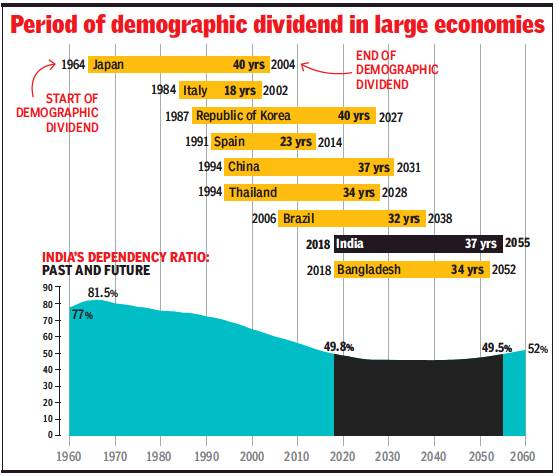Tapping Potential of Youth | 12 Jul 2021
This article is based on Tapping on the potential of the youth which was published in The Hindu on 12/07/2021. It talks about realising the potential of Indian youth in order to take advantage of India’s Demographic Dividend window.
In India over 62% of the population is aged between 15 and 59 years, and the median age of the population is less than 30 years. This means India is going through the stage of ‘demographic dividend’ representing the potential for economic growth based on the age structure of the population.
However, transforming this potential into reality requires adolescents and the youth to be healthy and well-educated.
A study on demographic dividend in India by United Nations Population Fund (UNFPA) said the window of demographic dividend opportunity in India is available for five decades from 2005-06 to 2055-56.
Therefore, more than the fears of a ‘population explosion’, it is critical that India focus attention on safeguarding young people’s well-being because India’s welfare hinges on them.
Demographic Dividend: Definition
According to United Nations Population Fund (UNFPA), demographic dividend means, "the economic growth potential that can result from shifts in a population’s age structure, mainly when the share of the working-age population (15 to 64) is larger than the non-working-age share of the population (14 and younger, and 65 and older)".
Challenges In Realising Youth Potential
- Lack of Education and Skill: India’s underfunded education system is inadequately equipped to provide the skills young people need to take advantage of emerging employment opportunities.
- According to the World Bank, public expenditure on education constituted only 3.4% of GDP in 2020.
- Another report revealed that India stands 62nd in terms of public expenditure per student, and fares badly in quality of education measures such as student-teacher ratios.
- Impact of the Pandemic: Various studies show that school closures have a serious impact on the learning, lives and mental well-being of children.
- A survey by the International Labour Organization (ILO) reveals that 65% of adolescents worldwide reported having learnt less during the pandemic.
- Issues of Young Women: Child marriage, gender-based violence, their vulnerability to abuse and trafficking, especially if primary caregivers fall ill or die. All these issues restrict young women to achieve their full potential.
- Jobless Growth: The main contributor in India’s GDP is the service sector which is not labour intensive and thus adds to jobless growth.
- Further about 50% of India's population is still dependent on agriculture which is notorious for underemployment and disguised unemployment.
- Low Social Capital: Further high levels of hunger, malnutrition, stunting among children, high levels of anaemia among adolescent girls, poor sanitation etc., have reduced the productivity of India’s youth in realising their potential.
Way Forward
- Inter-sectoral Collaboration: It is imperative to have in place mechanisms for better inter-sectoral collaboration to safeguard the futures of the young generation. Coordination across departments can enable better solutions and greater efficiencies in tackling any crisis.
- Eg.: Mid-day meals scheme not only provides an incentive for parents to send their children to school but also provides the calorie intake required to stay alert in the classroom.
- Skill Development to increase employability of the young population. India’s labour force needs to be empowered with the right skills for the modern economy.
- Government has established the National Skill Development Corporation (NSDC) with the overall target of skilling/up-skilling 500 million people in India by 2022.
- Improving Social Infrastructure: If India wants to leverage the economic potential of its youth bulge, then it must invest in improving social infrastructure viz. good health, quality education, and endeavour to provide decent employment to their entire population.
- Maintaining Basic Hygiene: As school closures have impacted access to schemes such as the delivery of menstrual hygiene products to adolescents, teachers can work as volunteers for collaborating with frontline health workers to distribute sanitary napkins to girls.
- Helpline For Youth: To address the mental health of adolescents, the Health and Education Ministries should strengthen outreach via existing helplines and by enabling conversations on critical issues regarding their reproductive and sexual health.
- Immediate Steps After Pandemic: It is important for policymakers to balance the risks of transmission through children with the harm of prolonged school closures.
- By prioritising the vaccination of teachers and school support staff and also allowing a decentralised approach where district-level officials may reopen schools based on local Covid-19 transmission rates, schools could be opened in a safe and phased manner.
Conclusion
Improving the lives of youth in mission mode would lift their lives, generate a virtuous cycle with healthier and educated young adults contributing substantially to securing India’s future.
The policies for empowerment of youth and their effective implementation will ensure that demographic dividend, which is a time-limited opportunity, becomes a boon for India.
|
Drishti Mains Question It is necessary to safeguard young people’s well-being because India’s welfare hinges on them. Examine. |

